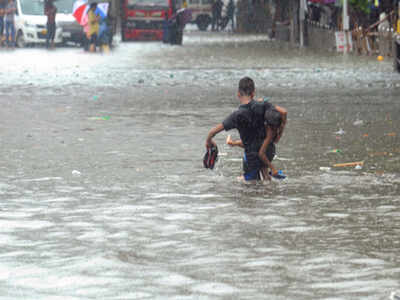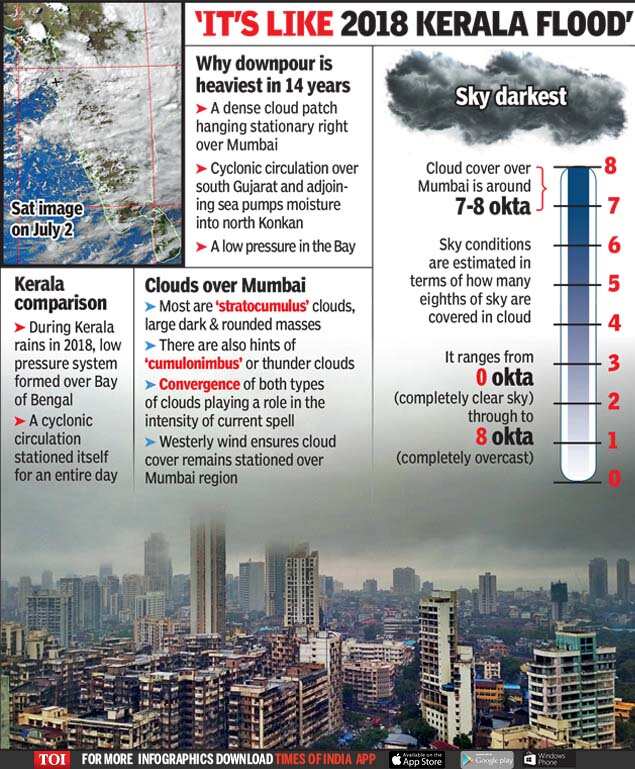
Mumbai receiving heavy downpour in two days points towards a very irregular pattern of rainfall that is now becoming regular in the past few years, according to a climate study expert, who compared it with last year's Kerala rains.
“This kind of events are becoming very regular where you get an extended dry spell and then the entire average of the month is covered in a few days," said Sridhar Balasubramanian, associate professor, department of mechanical engineering, and associate faculty IDP Climate Studies, IIT Bombay.

About the heavy downpour, he said, “Owing to the formation of the Bay of Bengal system, winds from Arabian sea were coming towards the city and on top of an upper level circulation was active. During such times, the cyclonic circulation formed shifts north to south but sometimes because of favourable wind condition the cyclonic circulation stays at one position for a long time. This gives rise to very heavy rains.”
He added, "This phenomenon is complicated as there are many conditions coming into the picture namely the Bay of Bengal low pressure system, the other being the offshore cyclonic circulation plus the upper air circulation and also the winds. All these factors make it hard to predict how the system is going to oscillate.”
Comparing it with last year's Kerala rains he said, "Last year Kerala too received heavy rains owing to a similar kind of situation. There was a low pressure system forming in the Bay of Bengal and then there was a cyclonic circulation which stationed itself for an entire day. Where exactly it would rain heavily is very difficult to pin point as if the circulation would have shifted slightly up or down Ratnagiri would have got more rainfall or if if had shifted up Vapi would have got heavy rainfall."
K S Hosalikar, IMD deputy director-general (western region), said there was a cloud patch right stationed over Mumbai. “Owing to this, Santacruz recorded over 200 mm rains in six hour, from 11.30pm Monday to 5.30am Tuesday. After 5.30am, there was a lull but rains again picked up later."
He also added, "Apart from it, another of the reasons for the extremely heavy rain spell Mumbai witnessed was a cyclonic circulation over South Gujarat and adjoining sea. "So when you have a circulation and a low pressure in the Bay this gives vigorous monsoon conditions over west coast and this accumulates over North Konkan region mostly(Which includes Mumbai)."
Meteorologists in IMD are linking the ongoing downpour in Mumbai to an effect of an array of weather systems that are working in tandem to bring heavy to very heavy rains in parts of north Konkan including Mumbai.
In fact, one of the systems known as a mid-tropospheric cyclonic circulation gained the maximum strength on Tuesday, further increasing the moisture being pumped into north Konkan. More the moisture availability over a region, higher is the chance of heavy rains.
Anupam Kashyapi, head of weather, IMD, Pune told TOI that the cloud cover over Mumbai is approximately 7-8 okta, which in layman’s terms indicates the presence of a huge amount of clouds. Sky conditions are estimated in terms of how many eighths of the sky are covered in cloud, ranging from 0 oktas (completely clear sky) through to 8 oktas (completely overcast).
“Mumbai and surrounding regions are currently witnessing completely overcast skies. The westerly wind flow is ensuring that the cloud cover hovers over this region. Most of these clouds are ‘stratocumulus’ clouds, which are large dark and rounded masses. With the lightning and thunder activity in Mumbai on Monday, we have also observed hints of ‘cumulonimbus’ or thunder clouds in this setup. The presence of both these types of clouds is also playing a role in the current heavy rains in Mumbai,” said Kashyapi.
Kashyapi said that the last few days have seen the development of several weather conditions, like the mid-tropospheric cyclonic circulation that has increased rainfall activity here. “This system persisted three to four days ago causing heavy rains over north Konkan. It gradually dissipated but has now formed again over the same region. As compared to July 1, the system’s height has increased, causing it to strengthen further. In fact, the system is the strongest currently in comparison to the last few days. This has led to more moisture being pumped over north Konkan and adjacent regions, resulting in heavy rains,” he said.
The westerly winds are simultaneously carrying moisture to the system, a perfect scenario for heavy rains. “In addition, other weather conditions like formation of a pressure gradient over the Arabian Sea off the Konkan coast has also resulted in wind convergence over north Konkan, further dragging in more moisture. If the moisture supply is to this extent over north Konkan, it is bound to cause heavy to extremely heavy rains, especially since the region is in the windward side of the Sahyadri range,” he said.
The Sahyadri range blocks rain-bearing winds, which causes rainfall on the western slopes, including coastal cities like Mumbai.
Meanwhile, the Central water Commission (CWC) has issued a flood alert for parts of Maharashtra. In its advisory for Mumbai on Tuesday, it said, " Due to extremely heavy rainfall already observed in many of the areas of Mumbai and its suburbs as well as forecast of very heavy rainfall with isolated extremely heavy rainfall in North Konkan on July 3, there is likelihood of urban flooding (Water Logging and Drainage Congestion) and associated inundation in view of the high tides associated with severe monsoon conditions in West Central Arabian Sea. Proper precautionary measures may continue. There is forecast of reduction in rainfall from July 4 but stray isolated heavy rainfall has been forecast till July 7."
The CWC advisory said that rivers having their source in Western Ghats and flowing into Arabian Sea may witness flash floods in association with the forecast rainfall during the next five days. Necessary precautions in the old bridges along the highways and along the Konkan Railway routes needs be taken as flow may increase suddenly along the course of these rivers in districts of Thane, Raigad, Ratnagiri, Sindhudurg in Maharashtra, Goa, among others.
“This kind of events are becoming very regular where you get an extended dry spell and then the entire average of the month is covered in a few days," said Sridhar Balasubramanian, associate professor, department of mechanical engineering, and associate faculty IDP Climate Studies, IIT Bombay.

About the heavy downpour, he said, “Owing to the formation of the Bay of Bengal system, winds from Arabian sea were coming towards the city and on top of an upper level circulation was active. During such times, the cyclonic circulation formed shifts north to south but sometimes because of favourable wind condition the cyclonic circulation stays at one position for a long time. This gives rise to very heavy rains.”
He added, "This phenomenon is complicated as there are many conditions coming into the picture namely the Bay of Bengal low pressure system, the other being the offshore cyclonic circulation plus the upper air circulation and also the winds. All these factors make it hard to predict how the system is going to oscillate.”
Comparing it with last year's Kerala rains he said, "Last year Kerala too received heavy rains owing to a similar kind of situation. There was a low pressure system forming in the Bay of Bengal and then there was a cyclonic circulation which stationed itself for an entire day. Where exactly it would rain heavily is very difficult to pin point as if the circulation would have shifted slightly up or down Ratnagiri would have got more rainfall or if if had shifted up Vapi would have got heavy rainfall."
K S Hosalikar, IMD deputy director-general (western region), said there was a cloud patch right stationed over Mumbai. “Owing to this, Santacruz recorded over 200 mm rains in six hour, from 11.30pm Monday to 5.30am Tuesday. After 5.30am, there was a lull but rains again picked up later."
He also added, "Apart from it, another of the reasons for the extremely heavy rain spell Mumbai witnessed was a cyclonic circulation over South Gujarat and adjoining sea. "So when you have a circulation and a low pressure in the Bay this gives vigorous monsoon conditions over west coast and this accumulates over North Konkan region mostly(Which includes Mumbai)."
Meteorologists in IMD are linking the ongoing downpour in Mumbai to an effect of an array of weather systems that are working in tandem to bring heavy to very heavy rains in parts of north Konkan including Mumbai.
In fact, one of the systems known as a mid-tropospheric cyclonic circulation gained the maximum strength on Tuesday, further increasing the moisture being pumped into north Konkan. More the moisture availability over a region, higher is the chance of heavy rains.
Anupam Kashyapi, head of weather, IMD, Pune told TOI that the cloud cover over Mumbai is approximately 7-8 okta, which in layman’s terms indicates the presence of a huge amount of clouds. Sky conditions are estimated in terms of how many eighths of the sky are covered in cloud, ranging from 0 oktas (completely clear sky) through to 8 oktas (completely overcast).
“Mumbai and surrounding regions are currently witnessing completely overcast skies. The westerly wind flow is ensuring that the cloud cover hovers over this region. Most of these clouds are ‘stratocumulus’ clouds, which are large dark and rounded masses. With the lightning and thunder activity in Mumbai on Monday, we have also observed hints of ‘cumulonimbus’ or thunder clouds in this setup. The presence of both these types of clouds is also playing a role in the current heavy rains in Mumbai,” said Kashyapi.
Kashyapi said that the last few days have seen the development of several weather conditions, like the mid-tropospheric cyclonic circulation that has increased rainfall activity here. “This system persisted three to four days ago causing heavy rains over north Konkan. It gradually dissipated but has now formed again over the same region. As compared to July 1, the system’s height has increased, causing it to strengthen further. In fact, the system is the strongest currently in comparison to the last few days. This has led to more moisture being pumped over north Konkan and adjacent regions, resulting in heavy rains,” he said.
The westerly winds are simultaneously carrying moisture to the system, a perfect scenario for heavy rains. “In addition, other weather conditions like formation of a pressure gradient over the Arabian Sea off the Konkan coast has also resulted in wind convergence over north Konkan, further dragging in more moisture. If the moisture supply is to this extent over north Konkan, it is bound to cause heavy to extremely heavy rains, especially since the region is in the windward side of the Sahyadri range,” he said.
The Sahyadri range blocks rain-bearing winds, which causes rainfall on the western slopes, including coastal cities like Mumbai.
Meanwhile, the Central water Commission (CWC) has issued a flood alert for parts of Maharashtra. In its advisory for Mumbai on Tuesday, it said, " Due to extremely heavy rainfall already observed in many of the areas of Mumbai and its suburbs as well as forecast of very heavy rainfall with isolated extremely heavy rainfall in North Konkan on July 3, there is likelihood of urban flooding (Water Logging and Drainage Congestion) and associated inundation in view of the high tides associated with severe monsoon conditions in West Central Arabian Sea. Proper precautionary measures may continue. There is forecast of reduction in rainfall from July 4 but stray isolated heavy rainfall has been forecast till July 7."
The CWC advisory said that rivers having their source in Western Ghats and flowing into Arabian Sea may witness flash floods in association with the forecast rainfall during the next five days. Necessary precautions in the old bridges along the highways and along the Konkan Railway routes needs be taken as flow may increase suddenly along the course of these rivers in districts of Thane, Raigad, Ratnagiri, Sindhudurg in Maharashtra, Goa, among others.
World Cup 2019
Trending Topics
LATEST VIDEOS
City
 Car gets stuck in water-logged subway in Mumbai's Malad, two men found dead
Car gets stuck in water-logged subway in Mumbai's Malad, two men found dead  'Extremely unfortunate’: Actor-turned-politician Sunny Deol tweets on row over appointing 'representative'
'Extremely unfortunate’: Actor-turned-politician Sunny Deol tweets on row over appointing 'representative'  1.4 lakh more CCTV cameras in second phase in Delhi
1.4 lakh more CCTV cameras in second phase in Delhi  Why no finance panel in MCG, councillors questioned mayor Madhu Azad
Why no finance panel in MCG, councillors questioned mayor Madhu Azad
More from TOI
Navbharat Times
Featured Today in Travel
Quick Links
Lok Sabha Election Schedule 2019Lok Sabha Election NewsDelhi Capitals teamMI team 2019Rajasthan Royals 2019RCB team 2019Maharashtra Lok Sabha ConstituenciesBJP Candidate ListBJP List 2019 TamilnaduShiv Sena List 2019AP BJP List 2019Mamata BanerjeeBJP List 2019 MaharashtraPriyanka GandhiBJP List 2019 KarnatakaAMMK Candidate List 2019BJP List 2019 WBLok Sabha Elections in Tamil NaduBSP List 2019 UPNews in TamilLok Sabha Poll 2019Satta Matka 2018PM ModiMahagathbandhanNagpur BJP Candidate ListChandrababu NaiduTamil Nadu ElectionsUrmila MatondkarNews in TeluguMadras High CourtTejashwi YadavArvind KejriwalTejasvi SuryaPawan KalyanArvind KejriwalYogi AdityanathJaya PradaSatta King 2019Srinagar encounter
Get the app





